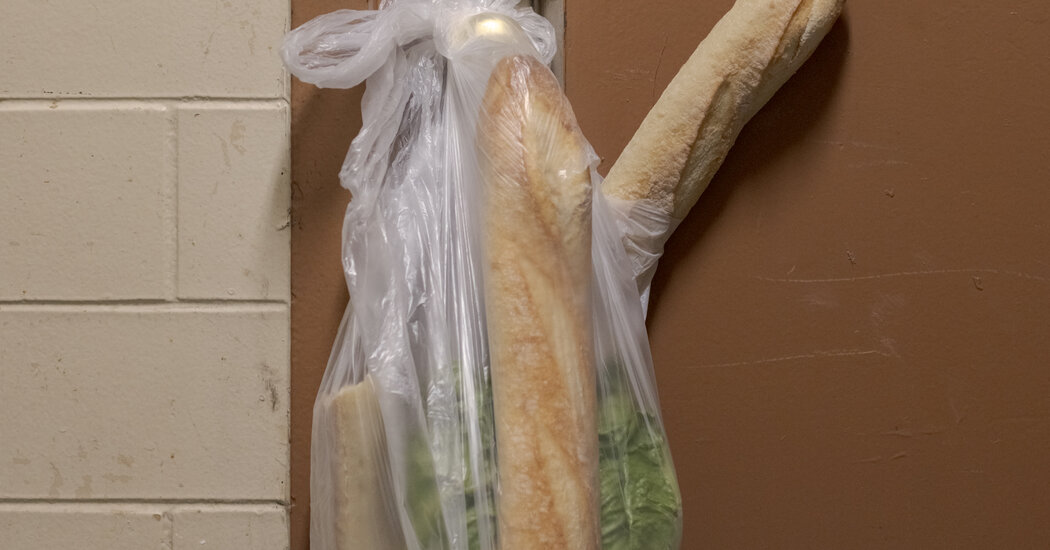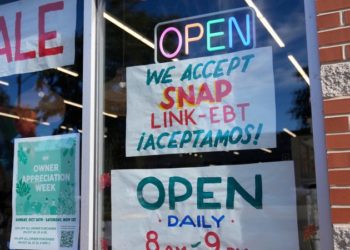Good morning. It’s Monday. Today we’ll look at New York City food banks, which are worried about the potential fallout from federal budget cuts.
This is an uncertain time for food banks in New York City. They are not sure how they will survive the Trump administration’s funding cuts, which could affect programs they turn to for help. Demand at food banks has skyrocketed amid the city’s affordability crisis, which has driven even people with jobs to seek the assistance that food banks provide. Almost two-thirds of food bank users are employed, according to the Poverty Tracker from Columbia University and the anti-poverty group Robin Hood.
I asked Sarah Maslin Nir, a Metro reporter who analyzed the problems facing food banks and the people who depend on them, to talk about where things stand as Republicans in Congress push ahead with a plan to cut food assistance.
What’s the scope of the cuts facing New Yorkers who rely on food stamps?
Just under three million people in New York State rely on food stamps, according to the New York City Food Policy Center at Hunter College. A bill championed by President Trump would cut $295 billion in food stamp spending over the next decade. That would affect the Supplemental Nutrition Assistance Program, known as SNAP.
The bill, as approved by the House, would also penalize states based on the percentage of food stamps they paid out in error. If that provision becomes law, New York State would have to kick in about 25 percent of the bill for food assistance.
In addition, the bill calls for barring noncitizens from using food stamps.
Those two elements of the bill seemed in jeopardy early last week, when the Senate parliamentarian said they conflicted with legislative rules. But late last week, Senate Republicans said they had devised a workaround that would allow them to slash food benefits for the poor to help pay for their sprawling package of tax cuts.
What has already been cut? What stands to be cut in the near term?
A lot, and food bank leaders told me they are already feeling the effects. In March, the Department of Government Efficiency took aim at Biden-era initiatives that had provided over $1 billion in grants to states to buy local food.
Trump administration-backed cuts of the Emergency Food Assistance Program have already hacked away millions of pounds of deliveries to food banks. That is because some initiatives, like one that gave food banks money to shop with local farmers, were ended this summer instead of in 2026, as originally planned. No new grants will be issued after the current funding expires.
The Trump administration’s 2026 budget proposal would also eliminate the Agriculture Department’s Commodity Supplemental Food Program, which provides food assistance for people over age 60.
In terms of food and actual meals that could be prepared, what do the cuts mean for food banks?
The Regional Food Bank of Northeastern New York typically receives 400 tractor-trailers of food from the Agriculture Department’s emergency assistance program each year. It’s things like strawberries from California, citrus from Florida and meat from the Midwest.
Cuts to the program will slice the number of trucks in half, which will cost the food bank about 5.8 million meals. So far 27 trailers, with food for about 750,000 meals, have already been canceled.
Visits to food banks have shot up in the last five years. How bad is food insecurity in New York?
It’s not great. Everything is more expensive these days.
New York City already has one of the largest populations of people who are considered food-insecure, meaning they frequently aren’t able to make ends meet when it comes to food. Almost three million New Yorkers struggle to put food on the table, according to data from Feeding America, a philanthropic organization.
That’s why average monthly visits to pantries and soup kitchens have increased 85 percent since 2019, according to an analysis of FeedNYC data by City Harvest, a food rescue nonprofit.
Conservatives who oppose large-scale federal programs often say that waste and fraud are rampant.
There is some documented fraud concerning food stamps, but experts say it’s not primarily overpayment, the problem being targeted by the bill. The problem is scammers.
People receiving SNAP benefits are given Electronic Benefits Transfer cards that work like a credit card, with a magnetic stripe. Scammers load up card readers with “skimmers,” devices that steal the data from the card and drain the account.
The cost is significant, not just to the needy people whose money is stolen but to taxpayers. The federal government spent at least $30 million paying back stolen benefits in the past year, according to the Agriculture Department. Advocates have pushed for a more secure type of card, without success.
What alternatives are there?
City Harvest is a nonprofit that “rescues” food that would otherwise go to waste — prepared sandwiches and salads that delis and restaurants don’t sell, meat from supermarkets that’s close to the sell-by date and packaged goods from wholesalers. The chief executive officer, Jilly Stephens, is already in overdrive to try to mitigate a shortfall.
Unlike her organization, food banks rely on federal funding, she said. In 2019 the many food pantries that City Harvest supplied had 25 million visits. Last year the number was 46 million. Stephens said the situation made the proposed cuts, and those that have already been imposed, so much more frightening.
“It is beyond our reach to fill in that gap if these things come to pass,” she said. “SNAP is a beautiful program — it’s critical.”
Weather
Expect a partly sunny day with a high of 87 and low of 75. Tonight, there will be a 40 percent chance of showers. Here’s how to stay cool when it’s so hot.
ALTERNATE-SIDE PARKING
In effect until Friday, the Fourth of July.
The latest New York news
-
Pride in the city: Millions gathered for New York City’s annual Pride March amid what some marchers described as the most hostile political environment for L.G.B.T.Q. Americans in decades.
-
Changing the electoral map: The campaign of Zohran Mamdani, the likely winner of the Democratic mayoral primary last week, focused on registering voters, and he appears to have drawn thousands of voters who did not vote four years ago.
-
Weed shops as gathering places: Cannabis dispensaries across the city are expanding their in-store offerings to make space for social events. One dispensary hosts mahjong nights, and others hold classes and block parties.
-
Medicare fraud: Federal prosecutors in Brooklyn say that hundreds of thousands of people were billed for medical equipment they didn’t ask for in a $10.6 billion scheme that was carried out by 11 defendants working for a criminal organization based in Russia.
-
Greenland gets a little closer: United Airlines has started a seasonal, nonstop flight from Newark Airport to the capital of the Arctic island, which President Trump has said he wants to acquire.
METROPOLITAN diary
Running late
Dear Diary:
The lady with butterfly eyelashes is tapping furiously on her phone. The motorman is singing “I’ve Been Working on the Railroad” in a rich basso.
The local mariachis are playing “La Bamba” for the third time, so I give them my last dollar and board the N.
It’s half past Canal Street and a quarter to Union Square. Of course, I’m running late.
— Richard Younger
Illustrated by Agnes Lee. Send submissions here and read more Metropolitan Diary here.
Glad we could get together here. See you tomorrow. — J.B.
P.S. Here’s today’s Mini Crossword and Spelling Bee. You can find all our puzzles here.
Ama Sarpomaa and Ed Shanahan contributed to New York Today. You can reach the team at [email protected].
Sign up here to get this newsletter in your inbox.
James Barron writes the New York Today newsletter, a morning roundup of what’s happening in the city.
The post Why Food Banks Are Worried Now appeared first on New York Times.




